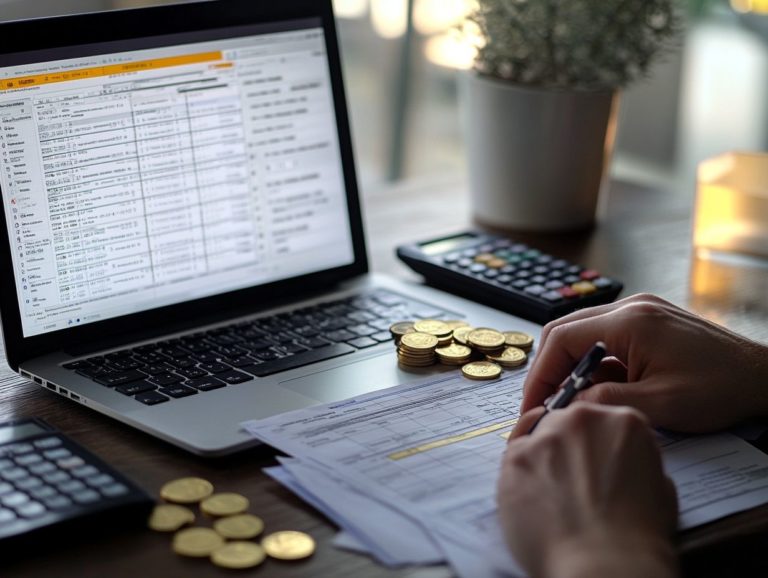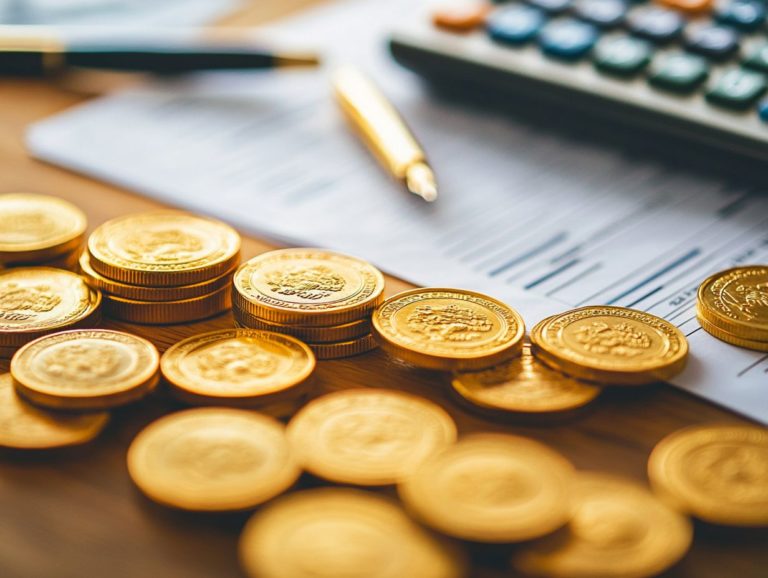Tax Strategies for Precious Metals in a Changing Economy
Precious metals have been treasured for their beauty and their vital role in the economy. As you consider investing in gold, silver, platinum, and palladium for diversification and security, understanding the tax implications is key.
This article explores the significance of precious metals in today s economy, current tax laws, and strategies to minimize tax liabilities. We ll look at various tax considerations associated with different metals, ensuring you re well-informed.
With economic conditions constantly changing, adapting your tax strategies is crucial to optimize your investments. Discover how to navigate the intricate world of precious metals and seize financial opportunities to your advantage.
Contents
- Key Takeaways:
- Overview of Precious Metals in the Economy
- Tax Considerations for Precious Metals
- Strategies for Minimizing Taxes on Precious Metals
- Tax Implications of Different Types of Precious Metals
- Adapting Tax Strategies to a Changing Economy
- Frequently Asked Questions
- What are tax strategies for investing in precious metals in a changing economy?
- How can a self-directed IRA help with tax strategies for precious metals?
- Are there any specific tax implications for investing in gold compared to other precious metals?
- What is the difference between short-term and long-term capital gains tax rates?
- What tax benefits are available for losses in precious metals investments?
- Should I consult a tax professional for personalized tax strategies for precious metals in a changing economy?
Key Takeaways:
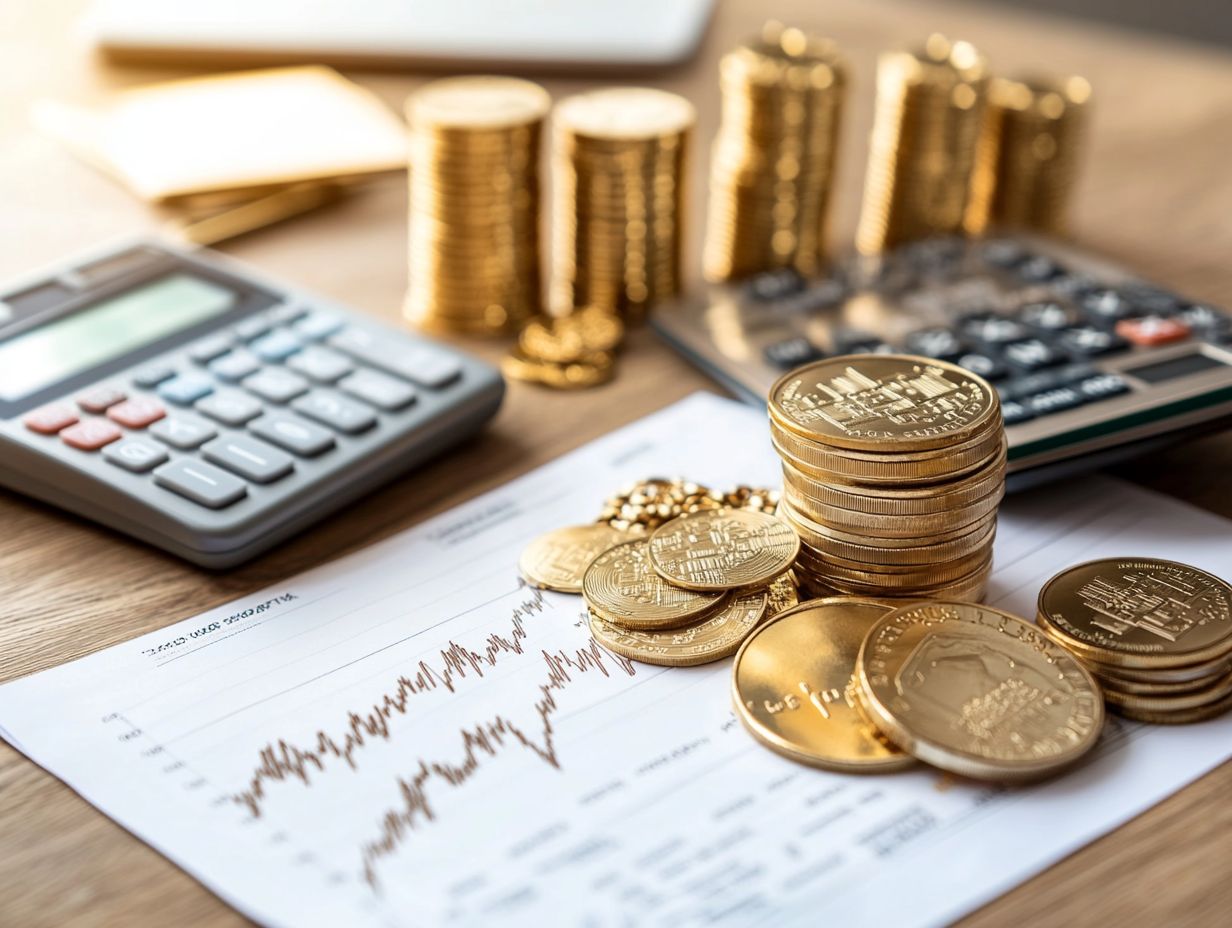
- Use tax-advantaged accounts like IRAs or 401(k)s to keep more money in your pocket.
- Time your purchases and sales wisely to minimize your tax bill.
- Donating precious metals can offer you tax benefits while supporting a great cause.
Overview of Precious Metals in the Economy
Precious metals gold, silver, and platinum serve as vital components in the global economy. They act as both investment vehicles and safe havens during economic uncertainty. Their intrinsic value and rich historical significance attract investors eager to diversify portfolios and safeguard against inflation.
The market behavior of these metals can profoundly impact financial strategies and capital flows, especially during periods of market volatility when stability and long-term growth are crucial.
Understanding how these assets fit into investment strategies is essential for making informed decisions in a changing financial landscape.
Role and Importance of Precious Metals
Gold and silver have played a crucial role in investing history. They serve not just as currency but also as reliable means to preserve wealth during economic uncertainty.
Over the centuries, these metals have evolved into symbols of stability in volatile markets. Their historical significance lies in their remarkable ability to retain value when other assets falter, making them attractive safe-haven investments during turbulent times.
In today’s investment portfolios, diversifying with these metals can hedge against inflation and currency fluctuations, tapping into your psychological need for security. As more individuals recognize the importance of balancing risk and reward, incorporating gold and silver into investment strategies has become a favored choice. To enhance your approach, consider exploring tax strategies for precious metals in today’s market, reflecting a blend of tradition and contemporary financial wisdom.
Tax Considerations for Precious Metals
Understanding how taxes affect your investments in precious metals is key to maximizing your returns and ensuring compliance with IRS regulations. This is particularly vital when it comes to capital gains tax and reporting requirements associated with different investment vehicles.
Stay informed to navigate the complexities of taxation and optimize your investment strategy.
Current Tax Laws and Regulations
Current IRS regulations outline specific tax implications for transactions involving precious metals, focusing on reportable activities such as selling gold bullion and coins.
You must track your transactions meticulously to ensure compliance. When selling precious metals, it’s essential to report any capital gains or losses on your federal tax returns, closely adhering to IRS guidelines. Depending on how long you ve held the asset, these gains could be subject to short-term or long-term capital gains tax rates. Short-term rates apply if you sell an asset you’ve owned for less than a year, which are typically higher than long-term rates for assets held over a year.
If you’re a collector dealing in rare coins, be mindful of additional reporting requirements related to collectible assets, including different tax treatments based on market valuation and classification.
Grasping these nuances is vital for anyone buying or selling these investments.
Strategies for Minimizing Taxes on Precious Metals
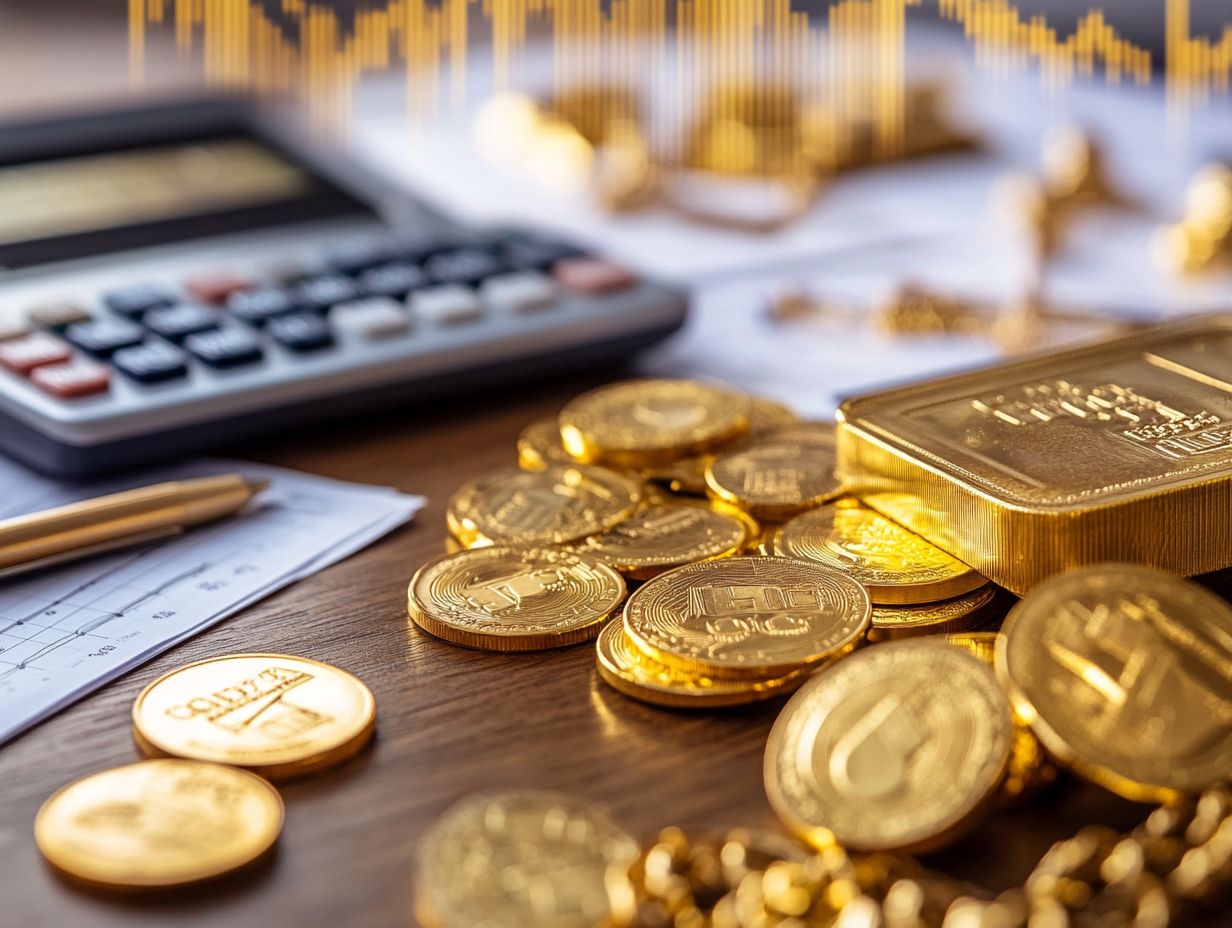
Effective tax planning requires you to implement strategies that minimize tax liabilities tied to your precious metals investments. This involves utilizing tax-advantaged accounts and capitalizing on any available tax deductions.
By approaching your tax strategy with foresight, you can enhance the overall profitability of your investments.
Tax-Advantaged Accounts
Investing in a precious metals IRA allows you to enjoy the benefits of tax deferral on capital gains. This makes it an appealing choice for long-term investors who are mindful of their tax liability.
This type of retirement account shields your assets from market volatility. It also provides unique tax advantages that traditional retirement accounts may not offer. By holding tangible assets like gold or silver, you can achieve peace of mind while potentially enhancing your financial portfolio with tax strategies for maximizing returns in precious metals.
Your age, financial goals, and risk tolerance significantly influence your investment strategy. If you’re nearing retirement, you may prioritize stability and wealth preservation. In contrast, younger investors might seek diversification to harness growth potential.
Ultimately, grasping how these accounts operate and understanding their benefits can empower you to make informed, strategic decisions about your retirement planning.
Timing of Sales and Purchases
The timing of your sales and purchases in the precious metals market can greatly influence your capital gains tax obligations, making careful planning essential for optimizing your financial outcomes.
Understanding the current market conditions is vital, as fluctuations in gold prices can dictate the most opportune moments for transactions. For example, selling during a peak price can lead to higher returns. As a buyer, you should also consider potential future increases when entering the market.
Using strategies such as holding onto your investments for over a year can yield significant benefits. Long-term capital gains typically enjoy lower tax rates. Employing tax-advantaged accounts or offsets enhances your financial strategies, ensuring that both sellers and buyers minimize their tax exposure while maximizing profit potential.
Act now to take advantage of favorable market conditions for the best returns!
Donating Precious Metals
Donating precious metals, like gold coins, offers you significant tax deductions. However, it s crucial to understand the IRS regulations surrounding collectible assets to optimize those benefits.
When you choose to contribute these valuable items to charity, you not only support worthy causes but also have the potential to lower your taxable income. The IRS allows you to deduct the fair market value of the donated precious metals, provided you ve held these collectibles for over a year.
This holding period plays to your advantage by cutting potential capital gains taxes incurred from selling the items. To stay in line with IRS regulations, make sure you obtain appraisals and maintain meticulous records of your contributions.
By effectively leveraging these tax deductions, you can transform your valuable assets into meaningful support for the nonprofits you care about, all while enhancing your overall financial strategy.
Tax Implications of Different Types of Precious Metals
Navigating the world of precious metals be it gold, silver, platinum, or palladium comes with unique tax implications that you must carefully consider. Understanding how these metals impact your capital gains tax obligations is essential for maintaining compliance and optimizing your investment strategy.
Capital gains tax is the tax you pay on the profit from selling your investments. Therefore, understanding these implications can help you make more informed decisions.
Explore your options today to optimize your investment strategy and minimize your tax burden!
Gold, Silver, Platinum, and Palladium
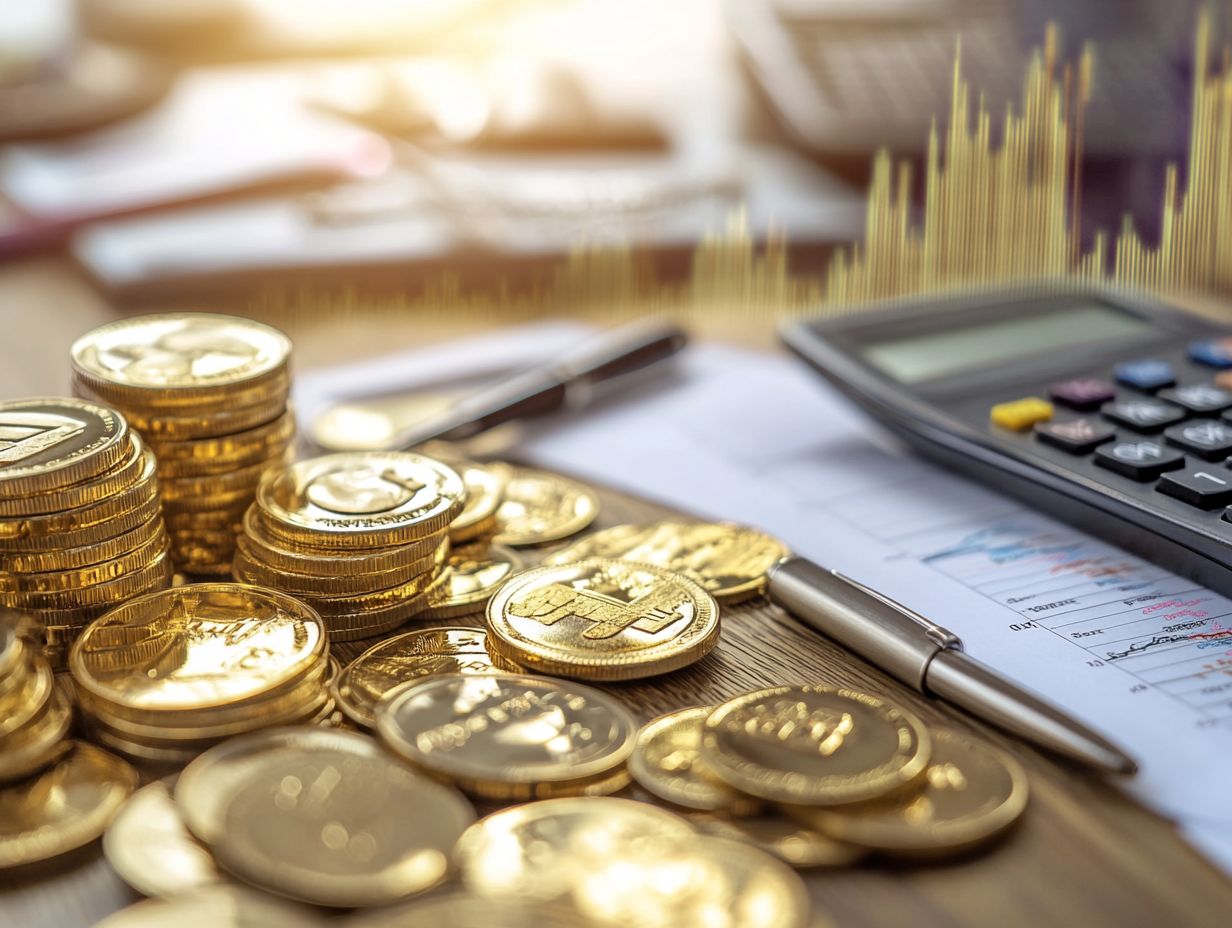
The IRS treats gold and silver quite differently than platinum and palladium for capital gains tax. This distinction can significantly influence your investment strategy.
As an investor in gold and silver, you’ll need to navigate the long-term capital gains tax rate that applies to collectibles, which is set at a higher threshold than traditional capital assets. Understanding the tax consequences of trading precious metals might steer you toward specific strategies designed to optimize your tax obligations.
In contrast, platinum and palladium are classified similarly to stocks and bonds. This classification allows them to benefit from lower capital gains tax rates, creating a more favorable landscape for diversifying your portfolio with these metals.
Understanding these nuances is essential for anyone looking to increase their profits while keeping tax liabilities in check.
Adapting Tax Strategies to a Changing Economy
In today s swiftly shifting economy, you need to refine your tax strategies to keep pace with market changes. By doing so, you ll ensure that your investment options remain effective for fostering financial growth.
Adaptation is key to maintaining a robust portfolio and maximizing your returns.
Impact of Economic Conditions on Precious Metals
Economic conditions wield considerable influence over precious metals, impacting their market value and shaping your investment strategies during times of uncertainty.
When the markets experience turbulence, you may gravitate toward these metals as a safe haven to safeguard your wealth. Currency fluctuations and inflation rates can intensify this trend, driving demand for gold and silver even higher.
As central banks adjust interest rates in response to economic shifts, holding precious metals as a hedge against currency depreciation becomes increasingly appealing.
The interplay of global economic indicators like employment rates and geopolitical tensions adds to the volatility of metal prices, influencing how you approach your portfolio during these unpredictable times.
Adjusting Tax Strategies Accordingly
Regularly adjusting your tax strategies in response to market conditions is essential for maintaining tax compliance and optimizing investment returns. Financial advisors are crucial for navigating these complexities.
In today s dynamic financial landscape, where changes can occur rapidly, you must stay proactive to seize every opportunity! A single misstep in your tax planning could result in missed returns or unwanted liabilities.
By conducting thorough analyses and leveraging up-to-date tax laws, financial advisors empower you to identify opportunities for selling losing investments to offset gains or strategic rebalancing aligned with your short-term and long-term financial objectives.
Collaborating with an advisor ensures that your adjustments reflect your overall strategies while remaining responsive to potential market shifts.
Frequently Asked Questions
What are tax strategies for investing in precious metals in a changing economy?
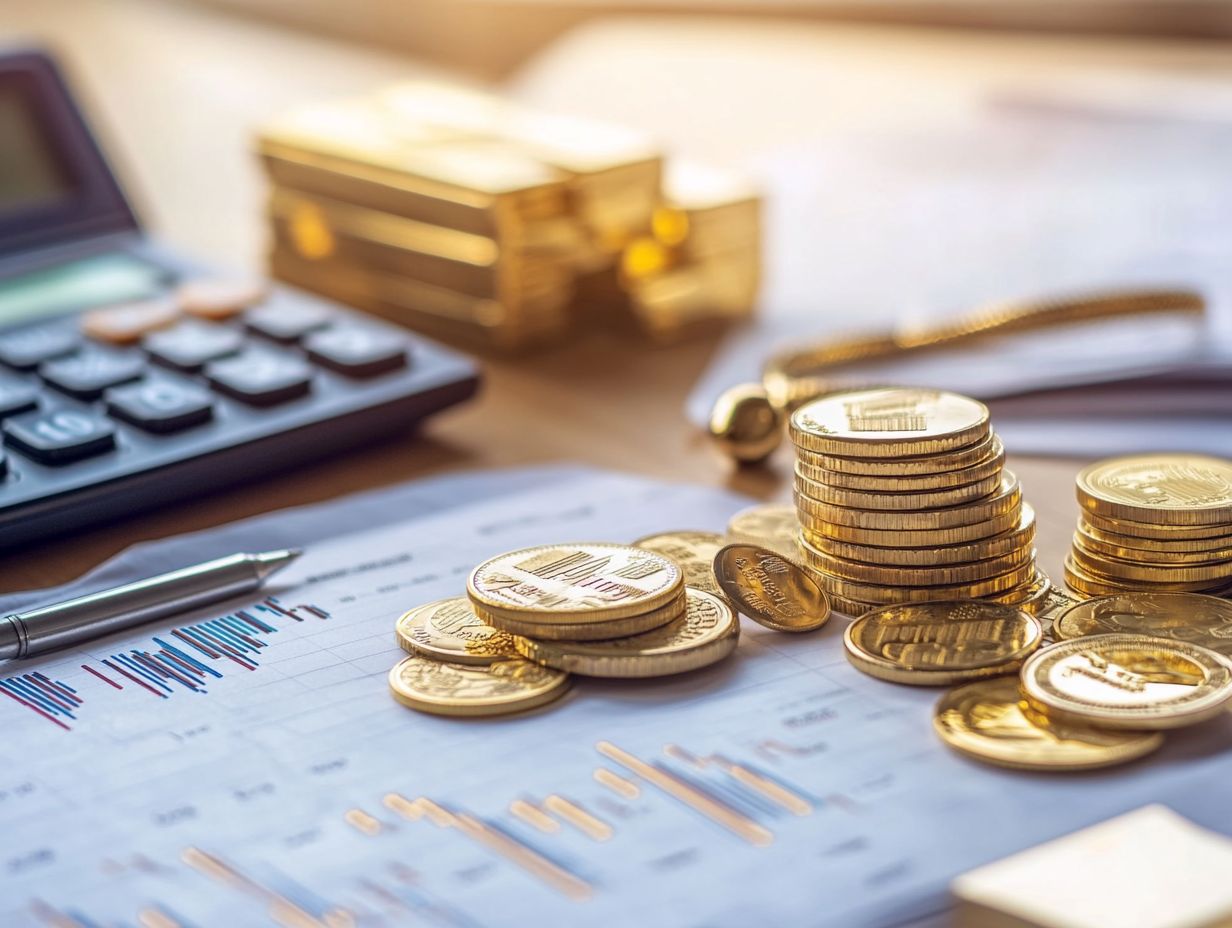
Tax strategies for investing in precious metals include utilizing tax-advantaged accounts, such as a self-directed IRA. Holding onto your investments for at least one year can help you qualify for long-term capital gains tax rates.
How can a self-directed IRA help with tax strategies for precious metals?
A self-directed IRA allows you to invest in precious metals without incurring immediate taxes on your profits. This can be beneficial in a changing economy, as it lets you potentially defer taxes until you retire or are in a lower tax bracket.
Are there any specific tax implications for investing in gold compared to other precious metals?
Yes, gold is considered a collectible by the IRS. It is subject to a higher tax rate of 28% on gains from investments held for less than a year.
Other precious metals, like silver and platinum, have regular capital gains rates.
What is the difference between short-term and long-term capital gains tax rates?
Short-term capital gains apply to investments held for less than one year. These gains are taxed at your regular income tax rate.
Long-term capital gains apply to investments held for one year or longer and are usually taxed at lower rates.
What tax benefits are available for losses in precious metals investments?
If you lose money on precious metals investments, you can use that loss to offset gains in other investments. This may help lower your overall tax bill.
Should I consult a tax professional for personalized tax strategies for precious metals in a changing economy?
Consulting a tax professional is always a smart choice, especially for precious metals investments. They can help you understand complex tax laws and find the best strategies for your needs.










